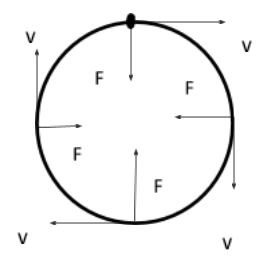
Answer
411.3k+ views
Hint: A particle moving in a magnetic field will experience force. So in this question we will find the direction of force acting on the particle and using this we will find the direction in which the particle will move. Based on this observation we will find the path of the particle.
Complete step by step answer:
We can see that as the particle moves in the magnetic field $B = {B_0}j$ a force will act on the particle. This force will be centripetal force which is given by following formula,
${F_C} = \dfrac{{m{v^2}}}{r}$
Where,
M is mass of the particle
V is the velocity of the particle
R is the radius of its path
If the charge on the particle is q then the magnetic field will apply a force which will be equal to $F = qvB$.
Since both the forces are applied by the magnetic field so we can equate these forces and we get following equation,
$\dfrac{{m{v^2}}}{r} = qvB$ -----(1)
From this equation we will find the radius of curvature
$r = \dfrac{{m{v^2}}}{{qvB}}$
$r = \dfrac{{mv}}{{qB}}$
There will be two components of velocity ${v_{perp}} = v\sin \theta $ and ${v_{para}} = v\cos \theta $
$\theta $ is the angle between v and B
As we can see in the question that the angle between v and B is ${90^\circ }$. So only the perpendicular component will remain and the parallel component will become zero. So the particle will move in a circular path only.

Path of particle moving in magnetic field $B = {B_0}j$ with velocity $v = {v_0}i$
Result- From above explanation, we can see that the path of particle moving with $v = {v_0}i$ in $E = {E_0}j$ and $B = {B_0}j$ is circular.
Note: In such a type of question we have to pay attention to the motion of the particle. If the particle is at rest then the path of the particle will be a straight line. If the angle between velocity and magnetic field is ${90^\circ }$ then the path will be circular. If the angle between velocity and magnetic field is $\theta $then the path of the particle will be helical.
Complete step by step answer:
We can see that as the particle moves in the magnetic field $B = {B_0}j$ a force will act on the particle. This force will be centripetal force which is given by following formula,
${F_C} = \dfrac{{m{v^2}}}{r}$
Where,
M is mass of the particle
V is the velocity of the particle
R is the radius of its path
If the charge on the particle is q then the magnetic field will apply a force which will be equal to $F = qvB$.
Since both the forces are applied by the magnetic field so we can equate these forces and we get following equation,
$\dfrac{{m{v^2}}}{r} = qvB$ -----(1)
From this equation we will find the radius of curvature
$r = \dfrac{{m{v^2}}}{{qvB}}$
$r = \dfrac{{mv}}{{qB}}$
There will be two components of velocity ${v_{perp}} = v\sin \theta $ and ${v_{para}} = v\cos \theta $
$\theta $ is the angle between v and B
As we can see in the question that the angle between v and B is ${90^\circ }$. So only the perpendicular component will remain and the parallel component will become zero. So the particle will move in a circular path only.

Path of particle moving in magnetic field $B = {B_0}j$ with velocity $v = {v_0}i$
Result- From above explanation, we can see that the path of particle moving with $v = {v_0}i$ in $E = {E_0}j$ and $B = {B_0}j$ is circular.
Note: In such a type of question we have to pay attention to the motion of the particle. If the particle is at rest then the path of the particle will be a straight line. If the angle between velocity and magnetic field is ${90^\circ }$ then the path will be circular. If the angle between velocity and magnetic field is $\theta $then the path of the particle will be helical.
Recently Updated Pages
How many sigma and pi bonds are present in HCequiv class 11 chemistry CBSE

Mark and label the given geoinformation on the outline class 11 social science CBSE

When people say No pun intended what does that mea class 8 english CBSE

Name the states which share their boundary with Indias class 9 social science CBSE

Give an account of the Northern Plains of India class 9 social science CBSE

Change the following sentences into negative and interrogative class 10 english CBSE

Trending doubts
Fill the blanks with the suitable prepositions 1 The class 9 english CBSE

The Equation xxx + 2 is Satisfied when x is Equal to Class 10 Maths

In Indian rupees 1 trillion is equal to how many c class 8 maths CBSE

Which are the Top 10 Largest Countries of the World?

How do you graph the function fx 4x class 9 maths CBSE

Give 10 examples for herbs , shrubs , climbers , creepers

Difference Between Plant Cell and Animal Cell

Difference between Prokaryotic cell and Eukaryotic class 11 biology CBSE

Why is there a time difference of about 5 hours between class 10 social science CBSE



